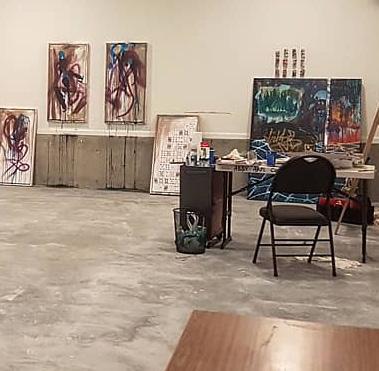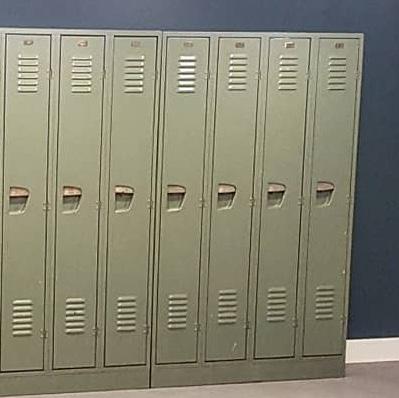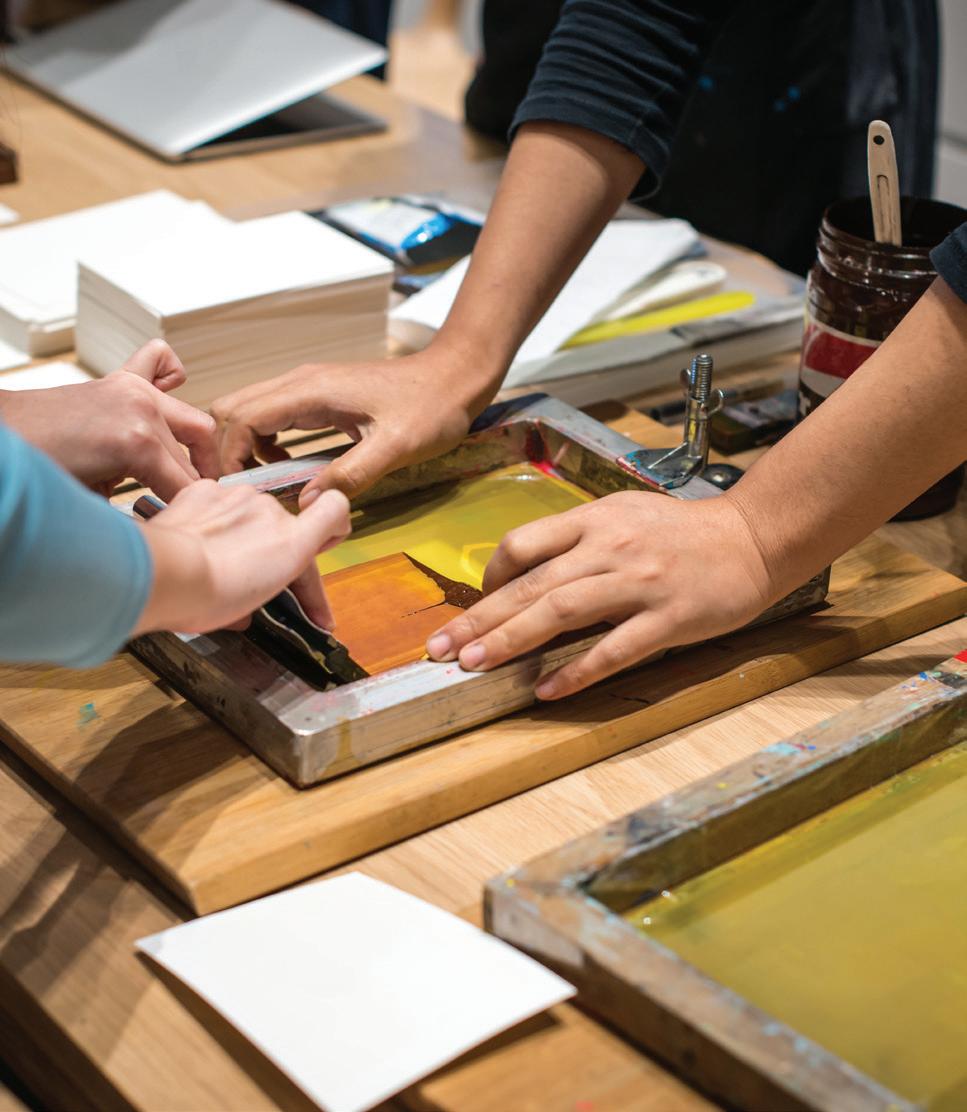
10 minute read
New artist collective builds custom studio
Artists creating community
Abby Arts Collective provides new studio space for local artists
Advertisement
KATIE STOBBART
26 A new shared art studio has opened in East Abbotsford, filling a gap in Abbotsford’s small-venue arts community. In some ways, Abbotsford is a city of makeshift arts venues. Its small music venues are breweries and one carport; one of its two art galleries is a small house; and studio space takes the form of second bedrooms, basements, and garages.
While a few larger venues exist (Abby Arts Centre, Matsqui Auditorium, Abbotsford Centre, the Reach Gallery Museum, and the new Railway space), it can be a challenge for local professional artists to set down roots without adequate spaces to perform, showcase, and create work. It’s a widely recognized gap in the arts community, brought up
routinely at all candidates’ meetings on culture, strategic conversations about the city’s cultural future, and at other fora for discussing local arts.
It’s also a niche that guided entrepreneurial artist Jesse Klassen to build a custom shared artist studio called Abby Arts Collective. Klassen is perhaps a rare combination of artist and construction worker, but he used his experience and contacts in both worlds to construct a unique, trailblazing addition to Abbotsford’s small arts venues. The idea sparked during his personal search for a professional arts studio where he could conduct his practice, and then gained traction as he realized there was a collective need.
“I saw a need I had, and looking into




how to resolve it, I realized there was a broader need. Through collaboration with other people, it was a need I could fill. And along the road, I came to realize I had a responsibility to do so,” says Klassen.
Shared arts studios are not a new concept; many exist in Vancouver and beyond, with tangible benefits for artists working in multiple media to collaborate, exchange feedback, and form community. New Westminster’s 100 Braid St. Studios, for instance, offers more than a dozen rentable industrial studio spaces to artists, and being part of the community there yields opportunities to show work, be promoted regularly on social media, discounts to arts events and pop-ups, and even an annual career coaching session.
While sharing space might be a challenge for those not used to the idea, many artists have found it supports and enhances their artistic practice.
“Although being limited with the amount of space at times, working in a shared studio … has helped propel me and make me more proactive with my work,” writes Frances Hogg for a blog on Bussey building, a shared professional studio in the UK. “It also helps me broaden my practice to become more

multi-disciplinary. As well as the dayto-day benefits of working together, sharing a studio can develop a shared public consciousness with your work, help alleviate a level of insecurity, and prepare you for exhibitions.”
Hogg’s studio points out that the feedback environment students learn in close quarters at art school often becomes “a compulsory part of their creative process,” meaning shared studios can be key for many artists to thrive in their work among professional peers.
Klassen agrees, citing his time in UFV’s senior studio as a source of inspiration for the art collective project.

“One of the things I loved about the senior studio, which is one room cordoned off for multiple people, is everyone working in the same space. There’s a sort of natural community that forms out of that. One thing that has been valuable in my own practice has been to call someone up and say, ‘Can I get your opinion on this?’” For example, Klassen explains: “If I’m working on a painting, I might call a videographer friend or a sculptural friend or a dancer. To get the perspective of another artist, you can see the work from a completely different viewpoint and enhance your work through that.”
It can make practical sense, too.
30 In an exploration of coworking relationships between artists, Artsy spoke with East London’s Francis Upritchard, a sculptor who works collaboratively with designer Martino Gamper.
“I don’t have to double up on tools,” Upritchard told Artsy. “Martino has a saw bench, welding setup, [and] tonnes of screws and fittings, which I pilfer from freely—along with the scrap wood piles.” Their arrangement saves money, and also means extra sets of hands for lifting heavy art pieces or materials.
But there are reasons this kind of studio environment, among other small arts venues, isn’t readily available in Abbotsford. For one, there’s an assumption that because the arts aren’t viewed as lucrative, arts organizations are destined to be non-profit charities that struggle to grow with limited funding and hopefully, donors. The myth of the starving artist is pervasive.
After looking for a studio space for about six months, having graduated and moved out of the senior studio with nowhere to store his materials, Klassen was continually stymied by too-high rents and spaces that don’t make sense as an art studio: there’s too little lighting, inadequate ventilation, and low ceilings that prevent contemporary arts practices. “Artists are told, the only restriction to your practice is the size of the space you work in,” Klassen says. So, he started to dream up what an affordable, open, bright, and wellventilated art space could look like in Abbotsford, drawing on his experience as a construction worker. “I kind of grew up in [construction],” he explains. “My dad owns a construction company. So I presented the idea of building a space to a

couple people, my parents included. They said they’d love to support me, but that this didn’t sound like a viable money-making scheme. I said I would do some research and get back to them on that because I think it is.”
And after considerable research and in-person interviews with fellow artists and organizations, he returned to prove that a shared artist studio had real potential not just to cover its expenses, but to turn a profit.
“I put together a plan, with a space for 10 artists renting at $250 per person.” With that in mind, Klassen calculated it would take about 10 years to recuperate the costs of building, with the costs of renting the space factored in. “That’s a really good investment. As far as investments go, you don’t recover your costs in 10 years—more like 20 or 30 years.”
Shortly after re-presenting his pitch, Klassen had the buy-in he needed to get started.
Then came the work of City approval, which Klassen says didn’t come easily. One of the challenges to this kind of project is that the City of Abbotsford does not have a zoning definition that accommodates an art studio or collaborative workspace. This, Klassen suggests, is an area where the City could do better as it develops a strategy for arts and culture (a process currently underway at time of writing).
“It’s one thing to say, ‘arts and culture’ and another to have an entrepreneur with a plan. If there’s no definition, we can’t integrate it [with the City’s plans]. Even if what we’re doing here is a huge step in the right direction,” says Klassen.
There are examples to follow if Abbotsford did seek to define


a wider range of cultural venues. Although Vancouver is a much larger city than Abbotsford, it has expansive zoning definitions, with three possible art studio designations: studios for the production of music or performing arts, studios for visual arts such as Klassen’s, and a designation to allow shorter term cultural use in a space. Vancouver also has funding available for professional artists who need studio space but for whom cost is prohibitive, among several other cultural grant streams.
But after a few such hurdles, the final project approval came, and Klassen’s team were able to start work on the building. Inclusive of space for 10 artists as planned, other key features of the studio include all the elements Klassen was looking for: high ceilings, good light, good ventilation.
“We wanted to give an opportunity for contemporary art to be made, so if someone wants to create a 10-foot mural, they can. We designed the space to be larger than life. You walk into the opening area, and [the ceiling] vaults up to 20 feet.”
Early days in the studio
I put on my studio coat, I make myself a pot of tea, and I grab my headphones. Right now, I’m finishing a large canvas painting that has been an ongoing project for the last six months; it will be the centrepiece of a show in September 2020. I’m also starting a new series of five paintings that I’ve been planning out for a little over a year! JESSE KLASSEN
When I get to the studio I almost always start by smearing paint on my fingers — just a little — it’s kind of a ritual act that sets me at ease and gets me in the right mindset for art-making. I only noticed myself doing it a few months ago, but I have a feeling I’ve been doing it for several years.

At this point I step back from my work, close my eyes, and visualize the next step. Sometimes it’s a specific detail like in the large canvas I’m finishing, and sometimes it’s just about being bold and messy.
When I finish the session, I give my station a quick clean — I get pretty messy when I’m working — organizing tubes and cans of material, cleaning any brushes I may have used. In a collective studio, considering the other artists is important, so I move my things to the side when I’m finished so other artists can maximize space if they need it.

There’s also a mezzanine with an office workspace, under which the ceilings of the main studio area are 11.5 feet high, still much taller than the average nine feet found in makeshift spaces like spare bedrooms.
“It’s a functional, contemporary studio—not just a garage we’re trying to repurpose. It’s filling a gap in the valley community: we don’t have anything like that,” Klassen says.
In the short term, Klassen is looking to get things rolling and connect with the community, so the collective will have opportunities to do shows or public works in conjunction with existing spaces like Kariton House, the Reach Gallery, and the City.
“[Right now] it’s my dream and vision,

but I want to get more people involved so we can make it our dream, our vision,” Klassen explains. “There are lots of arts things happening in Abbotsford: we’ve got Raspberry, the [Abbotsford] Arts Council, the Reach, UFV… we even have our own arts store, HOFA, and other things popping up that support the arts. I want to integrate into that. We’re not trying to pioneer a new avenue for artists, we’re trying to add to what’s already in existence.”
For now, the Abby Arts Collective building is up, several artists have moved in, and the studio serves as a quiet space, 2,245 square feet tucked away on Sumas Mountain, out of the city bustle, for those artists to create, collaborate, and form community.
CULTURE STRATEGY WHAT DOES CULTURE MEAN TO YOU ?


1
Take the online survey and enter to win a $100 Highstreet gift card
2
Register for a community workshop
get involved: The City will be hosting information sessions and surveys to hear what you have to say! Subscribe to www.letstalkabbotsford.ca to stay informed!
34 For more information email the Culture Coordinator at TKozma-Perrin@abbotsford.ca or call 604.864.5699. #AbbotsfordPRC #AbbyCulture Letstalkabbotsford.ca/culturestrategy
WHAT DOES CULTURE






